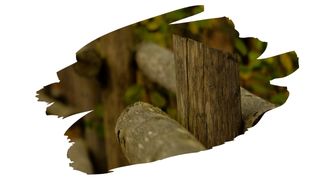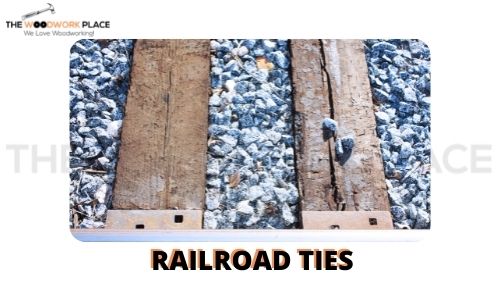The safest type of treated lumber, is one that won’t leech toxins into the soil. However, not all treated lumber is suitable for your backyard.
Take railroad ties, for example. Popularly used as fence posts on ranches, rail track supports are incredibly long lasting.
But, some of the treatments used to safeguard crossties, are likely to do more harm to you than good.
So, in this post, you will learn what kind of treatments have gone into railroad ties. You’ll also discover why some of these treatments are prohibited (outside of industrial uses).
And we reveal whether or not you can really risk placing those rail crossties in your garden.

This post may contain affiliate links to products that we receive a commission for (at no additional cost to you). Learn more here.
What Are Railroad Ties?
Railroad ties, (also referred to as railway sleepers or crossties), help to support metal rail tracks by keeping them evenly spaced.

Made from strong stable woods, crossties help manage the stresses placed on different sections of the track.
What Type Of Durable Wood Are Railroad Ties Made Out Of?
They usually made from stable wood types, such as White Oak, and Douglas Fir.
You see, stable wood doesn’t shift and warp any time it gets exposed to moisture or changes in humidity.
They are also rot-resistant and bug-resistant too, and can naturally stave off the decaying effects of wood rot.
And all of this is very important when it comes to railroad ties. Since the last thing you need is for crossties to shift around.
And What Kind Of Wood Preservatives Are In Railroad Ties?
For decades, the most widely used preservative in cross-ties was Creosote.
Creosote is the black tar you get when you burn wood. It can also be found in the smoke released from burning firewood.
However, creosote is incredibly carcinogenic and toxic. It can burn your skin if it gets onto it. And the creosote found in smoke can severely irritate your eyes.
As a result, this tar substance is only ever used to treat wood meant for industrial structures, such as telephone poles, bulkheads and railway sleepers.
And, outside of industrial purposes, creosote treatments are prohibited from being used on any timber sold to the wider public.
Does That Mean Railroad Ties Are Unsafe? When Can You Use A Railroad Tie In Your Garden?
Well, not all railroad ties are treated with creosote. That is because creosote is a fairly dated wood preservative. However, more environmentally safe treatments have begun to make their way into the industry.
For example, some railroad ties may have been treated with more eco-friendly preservatives. For example low-toxicity treatments, such as Alkaline Copper Quaternary ( ACQ) and Micronized Copper Azole (MCA), are on the rise.
ACQ and MCA copper-based treatments act like a fungicide, fighting off the bacteria that would otherwise allow wood rot to take hold.
Their copper element is also responsible for the green-tint these wood preservatives leave behind. This is because copper turns a green-blue color when it reacts with oxygen (and begins to oxidize). And that is why the term ACQ/MCA treated wood is often referred to as ‘Green’ Pressure Treated Wood.
Related Post: Can You Stain Landscape Timbers? (+ Our Top Time Saving Hacks)
Are Green Pressure Treated Wooden Fence Posts Safe To Have In My Garden?
Yes, they are. Much more so than any old railroad tie. ACQ treated wood in particular is one of the safest treated wood options for your garden.
Now, full disclosure, this water-soluble wood preserving treatment can still manage to leech into your garden soil. But, ACQ treated wood has amongst the lowest toxicity level out of all the different wood preservatives.
That’s why, according to the U.S. Environmental Protection Agency (EPA), ACQ treatments can be safely used on fences, and other landscaping timber.
However, these things are always constantly under review. And the current EPA guidelines regarding ACQ treated wood safety, can be subject to change in the future.
Related Post: Should You Use Nails Or Screws On A Wooden Fence? (Solved!)
Can You Use Untreated Wood For Fence Posts Instead?
Untreated wooden fence posts can be used outdoors. But, only provided they’ve been made from a stable durable wood.
Naturally rot resistant wood types such as White Oak, Western Red Cedar, and Douglas Fir, are all great outdoor lumbers.
In addition to that, you will need to pair durable wood with a quality end grain sealer. An end grain sealer will prevent wood grain from absorbing moisture from out of the soil.
You can learn more about end grain sealers, (and how to protect your untreated wooden fence posts), by checking out our post: How To Keep Your Landscape Timbers From Ever Warping Again.
So, Should I Use Railroad Ties Or Green Pressure Treated Fence Posts?
Stick to green pressure treated fence posts that have been infused with ACQ wood preservative. Out of the two options, ACQ is far safer for your garden than railroad tie fence posts.
To Wrap Up, Here Are The 3 Key Takeaways From This Post…
- 1). Railroad ties, (especially older ones), will have often been treated with very toxic wood preservatives, such as Creosote.
- 2). Creosote is a carcinogenic black tar substance that is harmful to humans. And it poses a risk to your health if it manages to leech into your garden soil.
- 3). Railroad ties that have been treated with ACQ (Alkaline Copper Quaternary) are safe to use in your garden as fence posts.
References:
C A Cushing, R Golden, Y W Lowney, S E Holm (2007): “Human Health Risk Evaluation of ACQ-Treated Wood“. Journal Human and Ecological Risk Assessment, volume 13, issue 5, pages 1014-1041.
The Creosote (Prohibition on Use and Marketing) | Legislation.gov.uk
Overview of Wood Preservative Chemicals | EPA.gov



